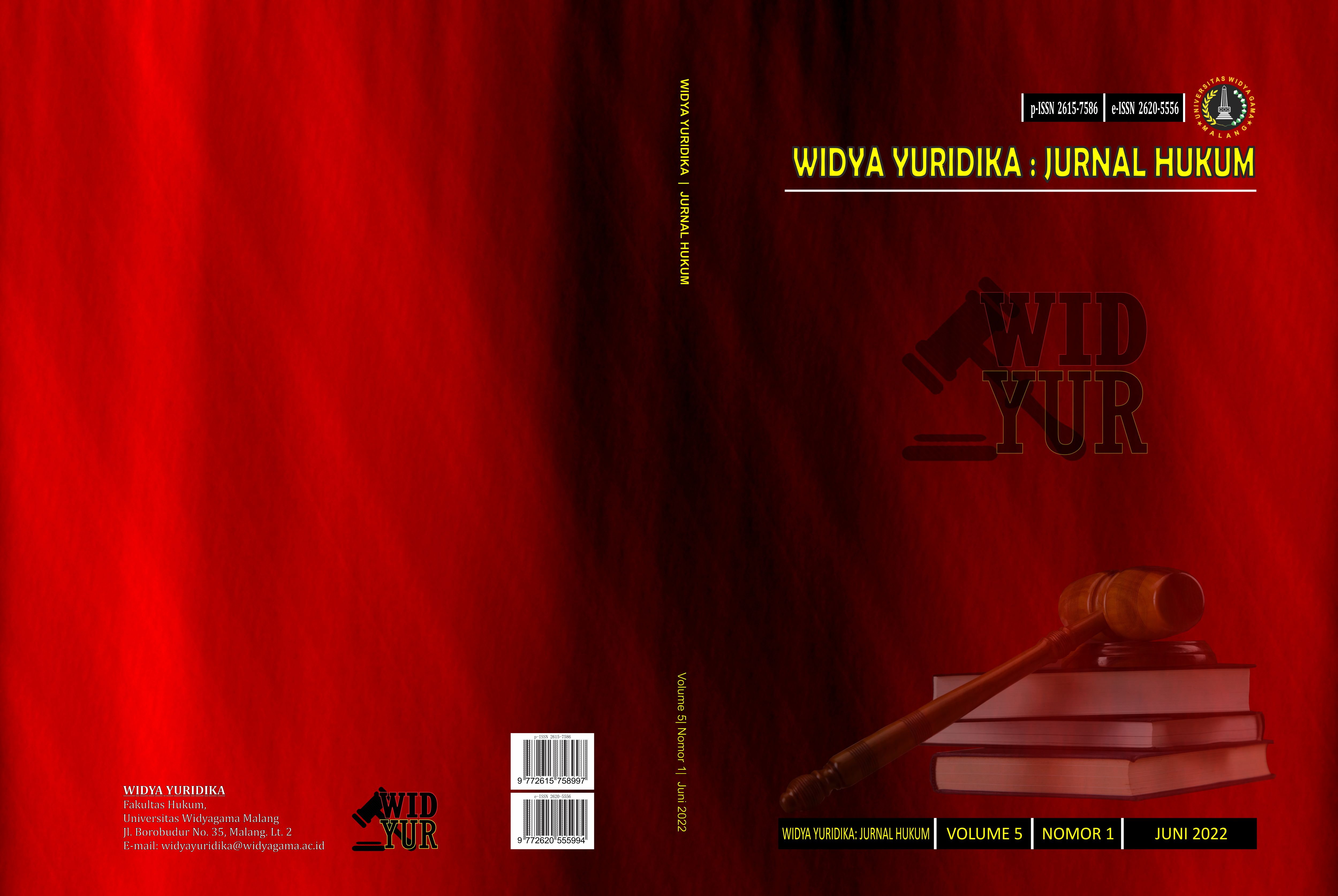Perbandingan Konstitusi Negara Indonesia Dan Rusia
DOI:
https://doi.org/10.31328/wy.v5i1.3561Keywords:
Comparison of the Constitution, Indonesia, RussiaAbstract
The purpose of this study is to analyze and compare the state constitutions of Indonesia and Russia, particularly in relation to state institutions, separation of powers, and institutions for interpreting the constitution. This study uses a normative juridical research method with a statutory approach and a comparative approach. The results of the study show that in terms of institutions, Indonesia and Russia both adhere to the trias politica separation. However, in terms of the government system, there are differences, if Indonesia adheres to a purely presidential system of government, the Russian Federation adheres to semi-presidential. As for the institutions of interpreting the constitution, there are also similarities and differences. Similarities such as being an interpreter of the constitution, being a dispute resolution institution for state institutions to providing opinions on impeachment. The difference is that if the Constitutional Court of the Republic of Indonesia has the authority to decide on the dissolution of political parties and disputes regarding the results of the general election, the Constitutional Court of the Russian Federation does not have that authority. On the other hand, the Constitutional Court of the Russian Federation does not have the authority, for example, to receive complaints about violations of constitutional rights, to decide on the constitutionality of agreements between Russian state government agencies, and to decide on the normative actions of Russian state officials.References
Buku
Asshiddiqie, Jimly. Pergumulan Peran Pemerintah Dan Parlemen Dalam Sejarah (Telaah Perbandingan Konstitusi Berbagai Negara). Jakarta: UI-PRESS, 1996.
———. Perkembangan & Konsolidasi Lembaga Negara Pasca Reformasi. Jakarta: Sinar Grafika, 2012.
Dahlan Thaib, Jazim Hamidi, Ni’matul Huda. Teori Dan Hukum Konstitusi. Cetakan Ke. Jakarta: PT. RajaGrafindo Persada, 2014.
Elgie, Robert. “Semi-Presidentialism in Europe.†In The Politics of Semi-Presidensialism. Oxford: Oxford Uni Press, 1999.
Fahmi, Ellydar Chaidir dan Sudi. Hukum Perbandingan Konstitusi. Yogyakarta: Total Media, 2010.
Gaffar, Janedjri M. Demokrasi Konstitutional: Praktik Ketatanegaraan Indonesia Setelah Perubahan UUD 1945. Jakarta: Konstitusi Press, 2013.
Isra, Saldi. Pergeseran Fungsi Legislasi Dalam Sistem Pemerintahan Indonesia Setelah Perubahan Undang-Undang Dasar 1945. Disertasi, Yogyakarta: Program Doktor Pascasarjana Fakultas Hukum Universitas Gadjah Mada, 2009.
Kah, Joseph Riwu. Analisa Hubungan Pemerintah Pusat Dan Daerah Di Indonesia. Jakarta: Bina Aksara, 1982.
Kelsen, Hans. Teori Hukum Murni: Dasar-Dasar Ilmu Hukum Normatif Sebagai Ilmu Hukum Empirik Deskriptif. Jakarta: Rumdi Press, 1995.
Malik, Jazim Hamidi dan. Hukum Perubahan Konstitusi. Jakarta: Prestasi Pustaka Publisher, 2009.
Marzuki, Peter Mahmud. Penelitian Hukum. Ke-5. Jakarta: Kencana Prenada Media Group, 2009.
Pasimio, Renanto R. The Philippine Constitution (It’s Evolution and Development) and Political Scince. Manila: National Book Store Inc., 1991.
Rakmat, Muhamad. Konstitusi Dan Kelembagaan Negara. Bandung: LoGoz Publishing, 2014.
Ranadireksa, Hendarmin. Arsitektur Konstitusi Demokratik. Bandung: Fokusmedia, 2007.
Sartori, Giovanni. Comparative Constitutional Engineering. London: McMillan, 1994.
Strong, C.F. Konstitusi-Konstitusi Politik Modern: Studi Perbandingan Tentang Sejarah Dan Bentuk-Bnetuk Konstitusi Dunia. Edited by terjemah dari Modern Political Constitution: An Introduction to the Comparative Study of Their History and Existing Form. Cetakan Ke. Bandung: Nusamedia, 2010.
———. Modern Political Constitution: An Introdaction to The Comparative Study of Their History and Existing From. London: Sidgwick & Jakcson Limited, 1960.
Syahrizal, Ahmad. Peradilan Konstitusi, Suatu Studi Tentang Adjudukasi Konstitusional Sebagai Mekanisme Penyelesaian Sengketa Normatif. Jakarta: Pradnya Paramita, 2006.
White, Stephen. Russia’s New Politics: The Management of a Post Communust Society. United Kingdom: Cambridge University Press, 2000.
Zоelva, Hamdan. Mengawal Kоnstitusiоnalisme. Jakarta: Konstitusi Press, 2016.
Jurnal
Chandranegara, Ibnu Sina. “Perbandingan Fungsi Dan Kedudukan Mahkamah Konstitusi Dan Lembaga Sejenisnya Di Tiga Negara (Indonesia, Austria Dan Perancis).†Al-Qisth Law Review 1, no. 1 (2017).
Firmansyah, Fahril. Eddy Purnama. “Perbandingan Kewenangan Mahkamah Konstitusi Antara Negara Republik Indonesia Dengan Negara Republik Chili.†Jurnal Ilmiah Mahasiswa Bidang Hukum Kenegaraan Fakultas Hukum Universitas Syah Kuala 1, no. 1 (2017): 132–43.
Hendratno, Edie Toet. “Desentralisai Dengan Sistem Federal Dan Pengaruhnya Terhadap Pelaksanaan Fungsi Negara.†Jurnal Hukum Dan Pembangunan XXXIII, no. 4 (2017): 469.
Lailam, Tanto. “Problem Dan Solusi Penataan Check and Balances System Dalam Pembentukan Dan Pengujian Undang-Undang Di Indonesia.†Jurnal Negara Hukum 12, no. 1 (2021): 123–27.
Pan Mohamad, Faiz. Muhammad Erfa Redhani. “Analisis Perbandingan Peran Kamar Kedua Parlemen Dan Kekuasaan Kehakiman Dalam Proses Pemberhentian Presiden.†Jurnal Konstitusi 15, no. 2 (2018): 232–40. https://doi.org/https://doi.org/10.31078/jk1521.
Rosmawan, Wawan. “Sejarah Perkembangan Konstitutionalisme Dunia Dan Indonesia (Tinjauan Perbandingan).†Jurnal Ilmiah Galuh Justisi 3, no. 2 (2015): 271–80.
Safriani, Andi. “Mahkamah Konstitusi Di Beberapa Negara Perspektif Perbandingan Hukum.†Jurnal Al-QadÄu 6, no. 1 (2019): 2019.
Santoso, M. Agus. “Perkembangan Konstitusi Di Indonesia.†Yustisia Jurnal Hukum 2, no. 3 (2013): 118–25.
Soetoprawiro, Koerniatmanto. “Konstitusi: Pengertian Dan Perkembangannya.†Jurnal Pro Justitia v, no. 2 (1987): 31.
Sonata, depri liber. “Metode Penelitian Hukum Normatif Dan Empiris: Karakteristik Khas Dari Metode Meneliti Hukum.†Fiat Justisia 8, no. 1 (2014): 25.
Zaky, Muhammad. “Perbandingan Judicial Review Mahkamah Konstitusi Indonesia Dengan Germany Federal Constitutional Court Dan Implikasinya Secara Global.†Transnasional 11, no. 1 (2016): 27–30.
Downloads
Published
How to Cite
Issue
Section
License
AttributionYou must give appropriate credit, provide a link to the license, and indicate if changes were made. You may do so in any reasonable manner, but not in any way that suggests the licensor endorses you or your use.
ShareAlike If you remix, transform, or build upon the material, you must distribute your contributions under the same license as the original.
Widya Yuridika: Jurnal Hukum allows readers to read, download, copy, distribute, print, search, or link to its articles' full texts and allows readers to use them for any other lawful purpose. The journal allows the author(s) to hold the copyright without restrictions. Finally, the journal allows the author(s) to retain publishing rights without restrictions
- Authors are allowed to archive their submitted article in an open access repository
- Authors are allowed to archive the final published article in an open access repository with an acknowledgment of its initial publication in this journal
========================================
Editor-in-Chief
Widya Yuridika: Journal of Law.
Faculty of Law, Universitas Widya Gama, Malang, Indonesia.

















